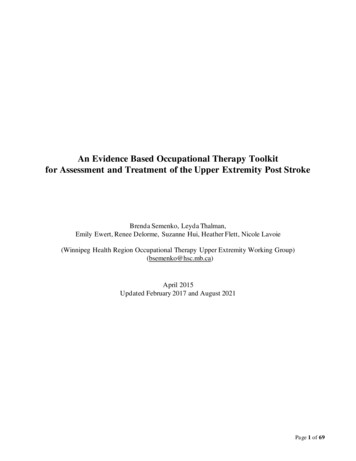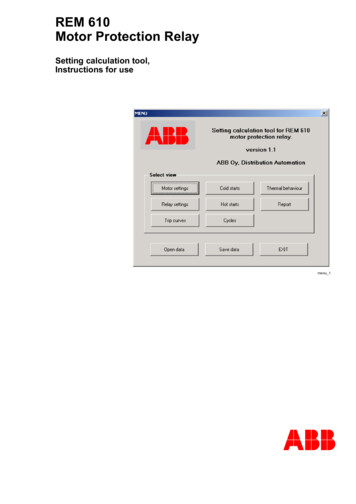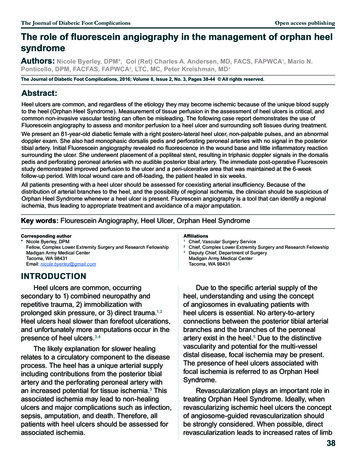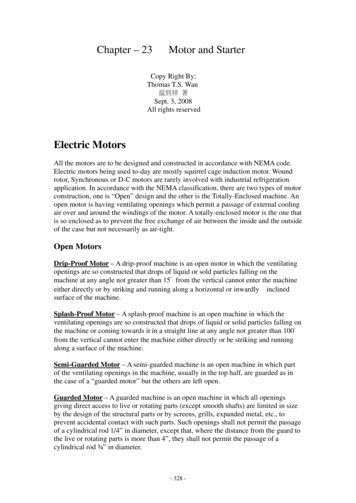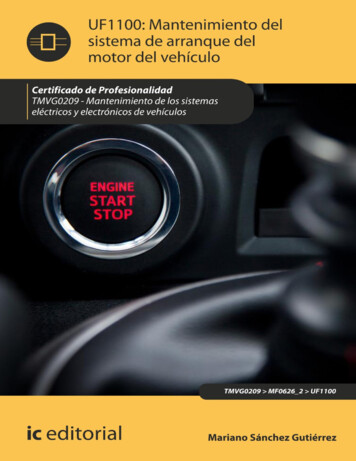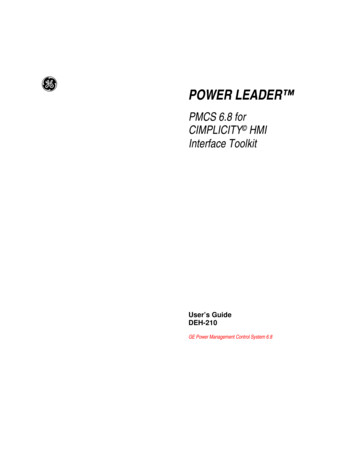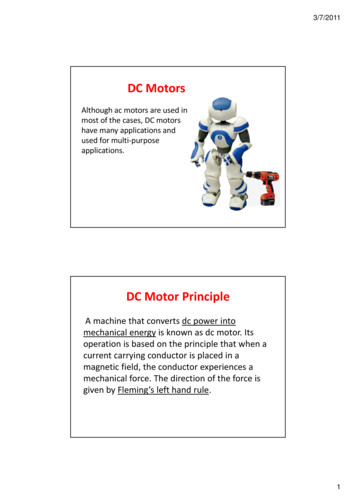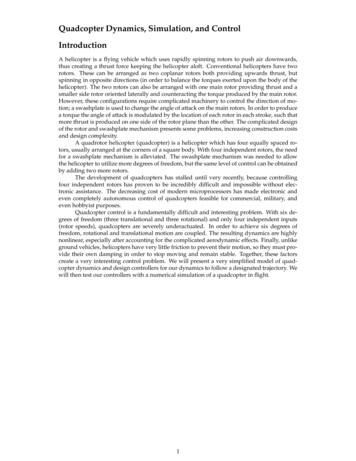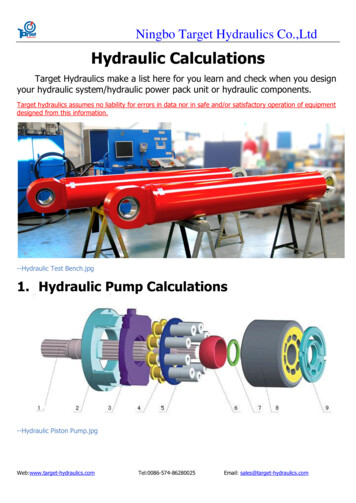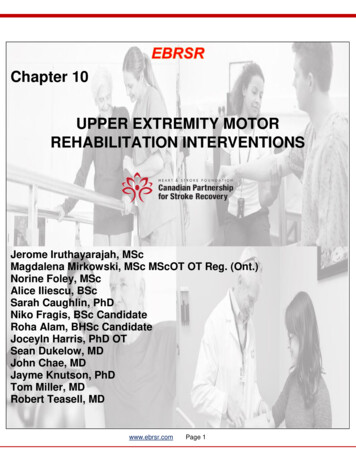
Transcription
10.8.2.1 Repetitive Transcranial Magnetic Stimulation (rTMS)Chapter 10UPPER EXTREMITY MOTORREHABILITATION INTERVENTIONSJerome Iruthayarajah, MScMagdalena Mirkowski, MSc MScOT OT Reg. (Ont.)Norine Foley, MScAlice Iliescu, BScSarah Caughlin, PhDNiko Fragis, BSc CandidateRoha Alam, BHSc CandidateJoceyln Harris, PhD OTSean Dukelow, MDJohn Chae, MDJayme Knutson, PhDTom Miller, MDRobert Teasell, MDwww.ebrsr.comPage 1
Chapter 10: Upper Extremity Motor Rehabilitation Interventions Table of contentsKey points . 4Modified Sackett Scale . 8New to the 19th edition of the Evidence-based Review of Stroke Rehabilitation . 9Outcome measures definitions .11Motor Function. 11Dexterity . 15Activities of daily living . 17Spasticity . 21Range of motion . 23Proprioception . 24Stroke severity . 25Muscle strength . 26Therapy based interventions .27Neurodevelopmental techniques . 27Bilateral arm training . 32Strength training . 41Task-specific training . 47Constraint-Induced Movement Therapy (CIMT) . 53Trunk restraint . 69Stretching programs . 72Orthotics . 75Mirror Therapy . 79Mental practice . 86Action observation . 91Music therapy . 95Technology based interventions .98Telerehabilitation . 98Robotics. 100Virtual reality . 114Brain computer interfaces . 123EMG biofeedback . 127Sensorimotor stimulation .132Neuromuscular electrical stimulation (NMES) . 132Transcutaneous electrical nerve stimulation (TENS) . 148Thermal stimulation . 152Muscle vibration. 155Additional afferent and peripheral stimulation methods . 158Invasive central nervous system stimulation .163Invasive cortical and nerve electrode implant stimulation . 163Non-invasive brain stimulation .166Repetitive Transcranial Magnetic Stimulation (rTMS) . 166Theta burst stimulation (TBS) . 177www.ebrsr.comPage 2
Transcranial Direct Current Stimulation (tDCS) . 182Pharmaceuticals .197Botulinum toxin . 197Steroids . 207Cerebrolysin . 209Levodopa . 211Atorvastatin. 213Antidepressants . 215Central nervous system stimulants . 218Complementary and alternative medicine .221Acupuncture . 221Electroacupuncture and transcutaneous electrical acupoint stimulation . 227Meridian acupressure and massage therapy . 232References .235www.ebrsr.comPage 3
Key pointsBobath concept approaches and motor relearning programmes may not be beneficial for upperlimb rehabilitation following stroke.Brunnstrom movement therapy may be more beneficial than motor relearning programmes forupper limb function.The literature is mixed regarding bilateral arm training for upper limb rehabilitation followingstroke.Bilateral arm training may not be beneficial compared to unilateral training for upper limbfunction.Bilateral arm training in combination with other therapy approaches may not be beneficial forupper limb rehabilitation.The literature is mixed regarding strength training and functional strength training for upper limbrehabilitation following stroke.The literature is mixed regarding strength training and functional strength training for upper limbrehabilitation following stroke.Task-specific training, alone or in combination with other therapy approaches, may be beneficialfor some aspects of upper limb function following stroke.Higher and lower intensity task-specific training may have similar effects on upper limb function.Constraint-induced movement therapy may be beneficial for upper limb rehabilitation in thechronic phase following stroke.The literature is mixed regarding constraint-induced movement therapy for upper limbrehabilitation in the subacute/acute phase following stroke.Modified constraint-induced movement therapy may be beneficial for upper limb rehabilitation inthe chronic phase following stroke.Modified constraint-induced movement therapy may not be beneficial for upper limbrehabilitation in the subacute/acute phase following stroke.Higher and lower intensity constraint-induced movement therapy may have similar effects onupper limb function in the chronic phase following stroke.The literature is mixed regarding constraint-induced movement therapy in combination withother therapy approaches for upper limb rehabilitation following stoke.Trunk restraint with reaching training or distributed constraint induced therapy may improvesome aspects of upper limb function following stroke, but the effect of combining trunk restraintwith constraint-induced movement therapy is less clear.www.ebrsr.comPage 4
Stretching programs may improve some aspects of upper limb function following stroke.Orthotics may not be beneficial for upper limb rehabilitation following stroke.Mirror therapy on its own or in combination with other interventions can improve many aspectsof upper limb function following stroke.Mental practice, alone or in combination with constraint-induced movement therapy, may bebeneficial for upper limb rehabilitation following stroke.Mental practice in combination with virtual reality training may not be beneficial for upper limbfunction.Action observation may be beneficial for some aspects of upper limb function following stroke.The literature is mixed regarding music therapy for upper limb rehabilitation following stroke.The literature is mixed regarding telerehabilitation for upper limb rehabilitation following stroke.The evidence is mixed regarding arm/shoulder end-effector robotics, alone or in combinationwith other therapy approaches, for upper limb rehabilitation following stroke.The evidence is mixed regarding arm/shoulder exoskeleton, hand exoskeleton, and hand endeffector robotics for upper limb rehabilitation.Virtual therapy alone may not be more beneficial than conventional therapy for upper limbrehabilitation following stroke, however it may be beneficial for certain aspects of upper limbfunction when used in combination with conventional or other therapy approaches.The literature is mixed regarding brain-computer interface technology for upper limb motorrehabilitation following stroke, either on its own or combined with other therapies, but it may notbe beneficial alone for other aspects of upper limb function.The literature is mixed regarding EMG biofeedback alone for upper limb rehabilitation followingstroke, however it may not be beneficial when combined with other therapy approaches.The literature is mixed regrading cyclic and EMG-triggered neuromuscular electrical stimulationtypes, as well as functional electrical stimulation, alone or combined with other therapyapproaches, for upper limb rehabilitation following stroke.The various types of neuromuscular electrical stimulation may not be more beneficial comparedto one another.Transcutaneous electrical nerve stimulation may be beneficial for some aspects of upper limbfunction following stroke.Noxious thermal stimulation may not be beneficial for upper limb rehabilitation following stroke,whereas innocuous thermal stimulation may improve some aspects of upper limb function.Muscle vibration may be beneficial for improving upper limb function following stroke.www.ebrsr.comPage 5
The literature is mixed regarding additional afferent and peripheral stimulation for upper limbrehabilitation following stroke.The literature is mixed regarding invasive cortical and nerve stimulation for upper limbrehabilitation following stroke.The literature is mixed regarding low frequency repetitive transcranial magnetic stimulation,alone or in combination with other therapy approaches, for upper limb rehabilitation followingstroke.High frequency repetitive transcranial magnetic stimulation, alone or in combination with othertherapy approaches, may be beneficial for upper limb rehabilitation.The literature is mixed regarding bilateral repetitive transcranial magnetic stimulation for upperlimb rehabilitation.Theta burst stimulation alone may not be beneficial for upper limb function following stroke,however it may be beneficial for certain aspects of upper limb function when used incombination with repetitive transcranial magnetic stimulation.The literature is mixed regarding anodal, cathodal, or dual transcranial direct current stimulation,alone or in combination with other therapy approaches, for upper limb rehabilitation followingstroke.Botulinum A likely improves spasticity in the upper limb following stroke, but not range of motionor activities of daily living. The effect on general upper limb motor function is conflicting and lessclear.Botulinum toxin A in combination with other types of therapeutic approaches may be beneficialfor certain aspects of upper limb function.Botulinum toxin B has been less well studied to date in comparison to botulinum toxin A.Steroid injections may not be beneficial for upper limb rehabilitation following stroke.Cerebrolysin may be beneficial for aspects of upper limb function following stroke.The evidence is mixed regarding Levodopa for upper limb rehabilitation following stroke.The evidence is mixed regarding atorvastatin for upper limb rehabilitation following stroke.Antidepressants may be beneficial for aspects of upper limb function following stroke.Dexamphetamine or methylphenidate may be beneficial for aspects of upper limb functionfollowing stroke.Methylphenidate combined with dual transcranial direct current stimulation may be beneficial forupper limb rehabilitation following stroke.The evidence is mixed regarding acupuncture alone for upper limb rehabilitation followingwww.ebrsr.comPage 6
stroke. Acupuncture combined with conventional or other therapy approaches may not bebeneficial for upper limb function. Some forms of acupuncture may be more beneficial thanothers.Electroacupuncture with neuronavigation-assisted aspiration may be beneficial for upper limbrehabilitation following stroke, however the evidence is mixed regarding electroacupuncture andtranscutaneous electrical acupoint stimulation.Both meridian acupressure and massage therapy may be beneficial for some aspects of upperlimb function following stroke.www.ebrsr.comPage 7
Modified Sackett ScaleLevel ofevidenceStudy designDescriptionLevel 1aRandomizedcontrolled trial (RCT)More than 1 higher quality RCT (PEDro score 6).Level 1bRCT1 higher quality RCT (PEDro score 6).Level 2RCTLower quality RCT (PEDro score 6).Prospectivecontrolled trial (PCT)PCT (not randomized).CohortProspective longitudinal study using at least 2 similargroups with one exposed to a particular condition.Level 3Case ControlA retrospective study comparing conditions, includinghistorical cohorts.Level 4Pre-PostA prospective trial with a baseline measure, intervention,and a post-test using a single group of subjects.Post-testA prospective post-test with two or more groups(intervention followed by post-test and no re-test orbaseline measurement) using a single group of subjectsCase SeriesA retrospective study usually collecting variables from achart review.ObservationalStudy using cross-sectional analysis to interpretrelations. Expert opinion without explicit critical appraisal,or based on physiology, biomechanics or "firstprinciples".Case ReportPre-post or case series involving one subject.Level 5www.ebrsr.comPage 8
New to the 19th edition of the Evidence-based Review of StrokeRehabilitation1) PICO conclusion statementsThis edition of Chapter 10: Upper extremity motor rehabilitation interventionssynthesizes study results from only randomized controlled trials (RCTs), all levels ofevidence (LoE) and conclusion statements are now presented in the PopulationIntervention Comparator Outcome (PICO) format.For example:New to these statements is also the use of colours where the levels of evidence arewritten.Red statements like above, indicate that the majority of study results when groupedtogether show no significant differences between intervention and comparator groups.Green statements indicate that the majority of study results when grouped togethershow a significant between group difference in favour of the intervention group.For example:Yellow statements indicate that the study results when grouped together are mixed orconflicting, some studies show benefit in favour of the intervention group, while othersshow no difference between groups.www.ebrsr.comPage 9
For example:2) Upper extremity rehabilitation outcome measuresFor the studies reviewed, upper extremity rehabilitation outcome measures wereclassified into the following broad categories to allow for synthesis of results andformulation of PICO conclusion statements:Motor function: These outcome measures covered gross motor movements and aseries of general impairment measures when using the upper extremities.Dexterity: These outcome measures assessed fine motor and manual skills through avariety of tasks, particularly with the use of a stroke survivor’s hand.Activities of daily living: These outcome measures assessed performance and levelof independence in various everyday tasks.Spasticity: These outcome measures assessed changes in muscle tone, stiffness, andcontractures.Range of motion: These outcome measures assessed a patient’s ability to freely movetheir upper extremity through flexion, abduction, and subluxation movements forinstance, both passively and actively.Proprioception: These outcome measures assessed sensory awareness about one’sbody and the location of limbs.Stroke severity: These outcome measures assessed the severity of one’s strokethrough a global assessment of a multitude of deficits a stroke survivor may experience.Muscle strength: These outcome measures assessed muscle power and strengthduring movements and tasks.Outcome measures that fit these categories are described in the next few pages.www.ebrsr.comPage 10
Outcome measures definitionsMotor FunctionAction Research Arm Test (ARAT): Is a measure of activity limitation in the pareticarm that assesses a patient’s ability to handle objects differing in size, weight andshape. The test evaluates 19 tests of arm motor function, both distally and proximally.Each test is given an ordinal score of 0, 1, 2, or 3, with higher values indicating betterarm motor status. The total ARAT score is the sum of the 19 tests, and thus themaximum score is 57. This measure has been shown to have good test-retest reliabilityand internal validity when used to assess motor function in chronic stroke patients(Ward et al. 2019; Nomikos et al. 2018)Brunnstrom Recovery Stages (BRS): Is a measure of motor function and musclespasticity in stroke survivors. The measure contains 35 functional movements which aredone with the guidance of a clinician (e.g. should abduction, shoulder adduction, legflexion/extension). These movements are evenly divided into 2 sections: upperextremity and lower extremity. Each movement is then rated on a 6-point scale(1 Flaccidity is present, and no movements of the limbs can be initiated, 2 Movementoccurs haltingly and spasticity begins to develop, 3 Movement is almost impossible andspasticity is severe, 4 Movement starts to be regained and spasticity begins to decline,5 More difficult movement combinations are possible as spasticity declines further.6 Spasticity disappears, and individual joint movements become possible). Thismeasure has been shown to have good reliability and concurrent validity (Naghdi et al.2010; Safaz et al. 2009).Disabilities of the Arm, Shoulder and Hand (QuickDASH): Is a shortened version ofDASH – a patient-reported outcome measure intended for upper extremity disorders. Itconsists of 11 items from the original 30-item DASH questionnaire, where each item has5 response options, with scaled scores ranging from 0 (no disability) to 100 (mostsevere disability). The measure is shown to be valid and reliable in populations withupper extremity disorders (Gummesson et al. 2006; Salaffi et al. 2018).Fugl-Meyer Assessment (FMA): Is an impairment measure used to assess locomotorfunction and control of the upper and lower extremities, including balance, sensation,and joint pain in patients poststroke. It consists of 155 items, with each item rated on athree-point ordinal scale. The maximum motor performance score is 66 points for theupper extremity section, 34 points for the lower extremity section, 14 points for thebalance section, 24 points for sensation section, and 44 points each for passive jointmotion and joint pain section, for a maximum of 266 points that can be attained. Theupper extremity section consists of four categories (Shoulder/Elbow/Forearm, Wrist,Hand/Finger, and Coordination) and includes 23 different movements which evaluate 33items. The items are scored on a 3-point rating scale: 0 unable to perform, 1 partialability to perform and 2 near normal ability to perform. The measure is shown to havewww.ebrsr.comPage 11
good reliability and construct validity (Okuyama et al. 2018; Villian-Villian et al. 2018;Nillson et al. 2001; Sanford et al. 1993).Finger Oscillation Test (FOT): Measures motor control and speed and is used to helpdetect brain damage through motor dysfunction by assessing the speed of fingermovement. It measures the maximal tapping speed of the index finger of each hand byrequiring the patient to work the lever arm of a mechanical counter up and down as fastas he or she can. The average number of taps in a 10-second interval is determined,and the patient performs five trials. The measure is considered a reliable indicator ofbrain function (Prigatano et al. 2004; Eng et al. 2013).Jebsen-Taylor Hand Function Test (JTHFT): Is a measure used to evaluate finemotor skills with weighted and non-weighted hand functions. The test is derived fromhand functions required for activities of daily living and is scored as the time taken (inseconds) to complete each subtest, with a maximum of 120 seconds permitted for eachsubtest. The test is shown to have good test-retest reliability (Allgower et al. 2017; Stern1992)Manual Function Test (MFT): Is an upper-limb function assessment measure used forevaluating proximal arm movements as well as fine and gross dexterity of hemipareticpatients after stroke. The test includes 8 subtests including forward and lateral elevationof arm, grasping, pinching, and pegboard manipulations, and ratings can range from 0(severely impaired) to 32 (full function). The measure has been shown to have goodreliability and validity (Miyamoto et al. 2009; Michimata et al. 2008).Motor Club Assessment (MCA): Is a measure of functional movement that indicatesbalance and movement by assessing the range of active movement for shouldershrugging, arm lifting, forearm supination, wrist cocking, and finger extension. Eachmovement is rated on a 3-point scale (where 0 no movement, and 2 full range ofmovement). (Sunderland et al. 1989)Motor Evaluation Scale for Upper Extremity in Stroke Patients (MES-UE): Is ameasure that assesses the quality of arm movement performance of the hemipareticarm and hand in stroke patients. The scale encompasses 10 arm function items with sixresponse categories (scores 0-5), nine hand function items with three responsecategories (scores 0-2), and three functional tasks with three response categories(scores 0-2). The measure is shown to be valid and reliable for measuring quality of armmovement in stroke patients (Van de Winckel et al. 2006).Motor Status Scale (MSS): Is a measure of upper limb impairment and disabilityfollowing stroke. It is divided into 4 sections and assesses shoulder, elbow/forearm,wrist and hand movements on a 6-point scale (maximum score 82 points). Thisclinical scale is thought to provide a more complete measurement of upper-limb motorfunction than the FMA, as it evaluates the complete range of motor function of the upperlimb by employing a finer grading of isolated movements. The scale has been shown tohave good validity and reliability (Ferraro et al. 2002; Wei et al. 2011).www.ebrsr.comPage 12
Rancho Los Amigos Functional Test for the Hemiparetic Upper Extremity (RLAFTUE): Is a measure used to quantify functional movement ability of the hemiparetic armin stroke patients. The test consists of a series 17 timed activities of daily living thatfocus on completion of everyday tasks involving the impaired limb (e.g., zipping ajacket, placing a pillow in a pillowcase). The tasks are arranged in seven levels bydegree of difficulty ranging from simple single joint movements at the shoulder tocomplex multi-joint movements involving the hand and arm. The test has been shown tohave high inter- and intra-rater reliability (Kahn et al. 2006; Wilson et al. 1984).Rivermead Motor Assessment (RMA): Is a multi-faced measure that assesses grossmotor function, leg and trunk movements and arm movements in post-stroke patients.The arm movements section consists of 15 items ranging from specific isolatedmovements (e.g. protracting shoulder girdle in supine position) to complex tasks (e.g.placing a string around the head and tying a bow at the back). Patients perform allmovements actively, and dichotomous scores indicate either success (score 1) or failure(score 0). The measure is shown to have good test-retest reliability, content validity, andconstruct validity (Dong et al. 2018, Van de Winckel et al. 2007).Sodring Motor Evaluation Scale (SMES): Is a measure of motor function andactivities in patients with stroke. It is comprised of 3 subscales that evaluate the motorfunction of the upper and lower limb, and gross motor function. The first 2 subscalesassess simple voluntary movements, while the third evaluates functional tasks includingtrunk movements, balance, and gait. The scale is comprised of 32 different items scoredusing a 5-point scale. The measure is shown to have good concurrent and constructvalidity, as well as good inter-rater reliability (Gor-Garcia Fogeda et al. 2014).Stroke Impairment Assessment Set (SIAS): Is a measure of overall motor functionand visuospatial ability in stroke survivors. The measure consists of 20 functional tasks(e.g. walking, combing hair, bending, tying shoes). These tasks are then subdivided into2 areas: tasks specific for the lower extremity and tasks specific for the upper extremity.Each task is then scored on a 6-point scale (0 cannot complete task, 5 completes taskas well as the unaffected side). This measure has been shown to have good reliabilityand validity (Panarese et al. 2016; Seki et al. 2014).Stroke Rehabilitation Assessment of Movement (STREAM): Is a measure of overallgross motor function in stroke survivors. The measure consists of 30 functional tasks(e.g. filling up and drinking from a cup, walking, getting into and out of the bathtub,buttoning a shirt). These tasks are then subdivided into 3 areas: upper limb, lower limband basic mobility. Each task is then scored on a 3-point scale (0 cannot completetask, 2 completes task as well as the unaffected side). This measure has been shownto have good reliability and validity (Mateen et al. 2018).Sollerman Hand Function Test (SHFT): Is a measure of general hand function anddexterity in stroke survivors. The measure consists of 20 functional tasks (e.g. stirringliquid, tying shoes, drinking from a cup, opening/shutting doors). Each task is thenwww.ebrsr.comPage 13
scored on a 6-point scale (0 cannot complete task, 5 completes task as well as theunaffected side). This measure has been shown to have good inter/intra reliability andvalidity (Singh et al. 2015; Brogardh et al. 2007).Stroke Upper Limb Capacity Scale (SULCS): Is a measure of basic arm capacitiesand overall arm strength in stroke survivors. The measure consists of 10 functionaltasks (e.g. carrying a briefcase, typing on a computer, writing on a notepad). Thesetasks are then subdivided into 3 areas: upper limb capacity with no control from wristand fingers, upper limb capacity with basic control from wrist and fingers, and upperlimb capacity with advanced control from wrist and fingers. Each task is then scored ona 3-point scale (0 cannot complete task, 2 completes task as well as the unaffectedside). This measure has been shown to have good reliability and concurrent validity(Houwink et al. 2011; Roorda et al. 2011).University of Maryland Arm Questionnaire (UMAQ): Is a measure of gross functionaldexterity in the upper arm for stroke survivors. The measure consists of 10 functionaltasks (e.g. opening/closing jars, opening/closing doors, reaching and grabbing commonhousehold items). Each task is then scored on a 6-point scale (0 cannot complete task,5 completes task as well as the unaffected side). This measure has been shown tohave good reliability and validity (Beebe et al. 2009, Bovend’ Eerdt et al. 2002).Upper Extremity Function Test (UEFT): Is a measure of total upper extremitydexterity and function in stroke survivors. The measure consists of 15 functional tasks(e.g. moving a jar around, stacking coins, reaching and grabbing a cup). There are 3subsections of the UEFT: (speed of execution, functional rating, task analysis). Eachtask is then meas
rehabilitation following stroke, however it may be beneficial for certain aspects of upper limb function when used in combination with conventional or other therapy approaches. The literature is mixed regarding

